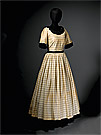Le Beau Danube [The Beautiful Danube]
Ballet in one act and two scenes
- Producer: Ballets Russes de Monte Carlo
- Premiere: 15 April 1933
- Venue: Théâtre de Monte Carlo, Monaco
- Costume design: Count Etienne de Beaumont
- Scenery design: Vladimir and Elisabeth Polunin, after Constantin Guys
- Music: Johan Strauss, arranged by Roger Désormière
- Choreography: Léonide Massine
- Libretto: Léonide Massine
- Main characters: The Mother, the Father, the Street Dancer, the Eldest Daughter, younger daughters, the Hussar, the Athlete, the Manager, the Artist, the First Hand, the Gardener, dandies, seamstresses, needlewomen, ladies of the town, salesmen
Set in the summer of 1860, the ballet opens in the Wiener Prater, a large public park in Vienna. A variety of Viennese citizens are out enjoying the sunshine—included in the crowd are artists, dandies, street performers, and a young hussar who meets and courts a beautiful young girl who is in the park with her aristocratic parents. One of the street performers, a young female dancer, recognises the hussar as a former lover and interrupts the courtship. The young girl faints from the emotional shock and is led away by her parents, while the dancer and hussar renew their acquaintance. The young girl returns and fights the dancer for the hussar’s affection. Finally the dancer retreats and all is forgiven between the hussar and the girl. The ballet ends with all the park-goers dancing in celebration, including the young dancer who has accepted the situation.
This work, with choreography and libretto both by Massine, was based on the ballet Le Beau Danube bleu, created by Massine in 1924 for Count Etienne de Beaumont’s Les Soirées de Paris. The Ballet Russe de Monte Carlo revived it in 1933 and it was included in the Monte Carlo Russian Ballet Australian tour of 1936 and again in 1940, when it was re-named Le Danube bleu.1 De Beaumont’s costume design reflected his knowledge and understanding of mid nineteenth-century Viennese fashion and manners, with light and elegant outfits for the main characters contrasting with earthier traditional dress for the street characters, all set against the open expanses of his interpretation of the Prater’s formal elegance.



